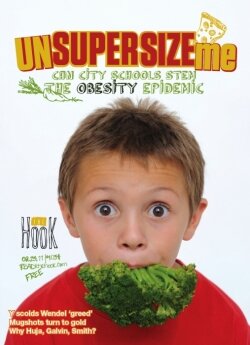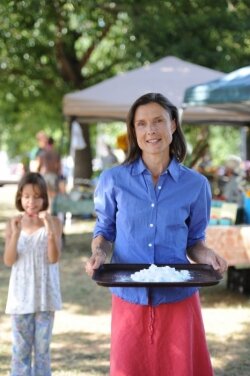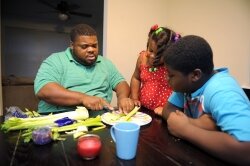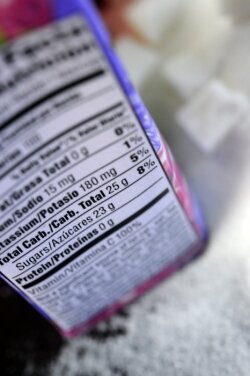Un-super size me: Can city schools stem the obesity epidemic?
-

-
 Ivana Kadija is running for School Board on a wellness platform and hopes to see sugar restricted in city schools.Jen Fariello
Ivana Kadija is running for School Board on a wellness platform and hopes to see sugar restricted in city schools.Jen Fariello -
 Harold Folley and his 8-year-old daughter Satatianna check the corn they have growing in their city backyard.Jen Fariello
Harold Folley and his 8-year-old daughter Satatianna check the corn they have growing in their city backyard.Jen Fariello -
 "We make sure we have greens in our dinner," says Harold Folley, with 8-year-old Satatiana and 11-year-old Sadarius.Jen Fariello
"We make sure we have greens in our dinner," says Harold Folley, with 8-year-old Satatiana and 11-year-old Sadarius.Jen Fariello -
 "I don't think we should have any sweetened beverages at all, period," says Ivana Kadija, who notes that fruit juice-- like the juice box pictured-- packs lots of sugar but few nutrients.Jen Fariello
"I don't think we should have any sweetened beverages at all, period," says Ivana Kadija, who notes that fruit juice-- like the juice box pictured-- packs lots of sugar but few nutrients.Jen Fariello
If Ivana Kadija ever hears Tony the Tiger telling kids his Frosted Flakes are "Grrrrreat!" she'll probably tell him to shut his furry trap. It's high-sugar food like that, says Kadija, chair of Charlottesville's School Health Advisory Board and a recently announced School Board Candidate, that's leading more local youths down the wide path to obesity and diabetes. Citing statistics that show a full one-third of city students are overweight by fourth grade, she wants the school system to make some not-so-sweet changes.
"We're in an obesity epidemic," says Kadija, a nutrition coach and mother of two elementary school aged daughters attending city schools, who unhappily recalls her first impression of the cafeterias.
"I noticed the free breakfast given out was some cereal or some sugary yogurt, animal crackers, and juice. I remember thinking, 'No, I think she'll eat breakfast at home.'"
Is sugar really Public Enemy #1 when it comes to healthy eating? That depends on whom you ask.
"Balance, variety and moderation with eating and physical activity are the keys to a healthy life," says Sandra Vazquez, head of the City School's nutrition program. "Sugar is not the bullet in the obesity problem, nor is removing it entirely the single solution."
So how much sugar is too much?
This year, City schools allow 30 percent of calories to come from sugar. That's less than the weight permitted by federal standards, but Kadija says it's still way too much. For instance, in a 100-calorie snack there can be nearly nine grams of sugar, the equivalent of more than two teaspoons.
Indeed, the heaps of added sugar can come as a shock. A slice of bread typically contains three grams– nearly a teaspoon. How about a container of low-fat Yoplait yogurt? With 14 grams (some from naturally occurring milk sugar), that's more than 3 teaspoons. Even the ground meat served in the school cafeteria contains added sugar, Kadija says.
In 2009, the American Heart Association released guidelines for adults suggesting an added sugar limit of just six teaspoons per day for women and nine for men.
"Why are children allowed to eat and drink so much more than that amount during the school day?" asks Kadija.
It's easy to see how school-day sugar can add up stunningly fast. Birthday parties with cupcakes can happen more than once a week (as much as 60g per frosted cupcake); french toast in syrup was sometimes served for lunch along with the daily choice of chocolate milk (at least 10g of added sugar for the milk alone). And don't forget ice cream on Fridays and the sweet treats– Tootsie Rolls and Jolly Ranchers– that some teachers routinely hand out to reward good behavior.
"It's clear that sugar is something we are absolutely addicted to," says Kadija, citing French research showing rats prefering intense sweetness even to cocaine.
"It makes you feel happy for a moment," she says, "but you crash 10 minutes later, and you're hungrier than you were in the first place."
That, she says, is no recipe for learning.
"Here we're putting this stuff in front of them all day long," she says, "and then they're imprisoned, supposed to sit in their chairs all day long."
Kadija's enthusiasm has won her support from high-profile members of the national food-writing community such as Ed Bruske, a former Washington Post reporter who blogs as "The Slow Cook." Calling her a "dynamo," Bruske, in his April 5 post, also lauds the 200 person-strong turnout for the Charlottesville screening of the school food-bashing documentary, Lunch Line.
But those working on the front lines of Charlottesville City School's nutrition program say that while Kadija's singular focus on restricting sugar may be well received by some parents, it downplays the immense challenges of feeding several thousand kids, more than half of whom qualify for free and reduced cost meals.
"We have 95 cents to spend on food per meal," notes nutritionist Vazquez.
Anyone trying to find local or organic food can imagine that a dollar doesn't go very far in filling a plate. Meanwhile, federal law further complicates the picture with rules stipulating everything from the total calories to daily allocations of meat, protein, fruits, and vegetables.
Buying in bulk directly from the United States Department of Agriculture offers low pricing on things like meat and eggs, but Vazquez credits school dietician Alicia Cost with constantly seeking ways to improve quality and increase local produce.
This past year, for instance, the school division used a grant to purchase 600 pounds of grass-fed local beef for a week's worth of meals, and the division sourced some fruits and vegetables from local growers through the Local Food Hub, a nonprofit that connects small farms to individuals and institutions.
Food Hub head Kate Collier calls Cost a "trailblazer at working through the system, making progress, really personally figuring out how it all works."
In September, in conjunction with the Virginia Department of Agriculture and Consumer Services, the Food Hub will award Cost and her boss Vazquez the Trailblazer Award for their efforts to incorporate local foods in school menus.
While Kadija applauds that effort, she says she remains stumped by what she sees as resistance to slashing sugar. Last year, she won what she thought was a small victory by convincing Clark Elementary School principal Gina Keller to limit chocolate milk at lunch to just once per week. Later in the year, to her chagrin, daily chocolate milk was back.
"The chocolate milk drinkers didn't start drinking the white milk," Kadija says, and "the assistant superintendant was concerned that kids weren't getting enough calcium."
Assistant superintendant James Henderson says the schools have removed other flavors of milk, but says if the chocolate variety is removed, many kids will instead choose juice.
Kadija is unmoved.
"There's no need for juice in schools either," she says. "They should be drinking water."
A UVA-trained endocrinologist board certified in internal medicine, Dr. Zachary Bush, agrees.
"The management of processed sugars in the liver increases inflammation," Bush explains, "which thus increases the epidemic diseases of America including diabetes, heart disease, and cancer."
As for milk, chocolate or white, Bush says it should all be removed from schools– and home refrigerators– because most of the population has some degree of lactose intolerance.
"We're not engineered for lactose," says Bush of the simple sugar that is the primary ingredient in milk and which, he says, "is capable of growing a calf 400 pounds in six months." Schools, he says, could meet calcium requirements by serving dark green vegetables like broccoli and spinach, and even adult women, often told to supplement calcium for bone density via dairy products, are misled.
"Calcium for bone density is an invented story by the dairy lobby," says Bush, who runs the holistic Revolution Health Center in Scottsville. "There has never been a study to show that an increase in calcium increases bone mineral density."
Bush says that sugar reduction serves to increase bone mineral density and eliminate damaging inflammation.
And while Bush would advocate a mostly vegan diet, heavy on vegetables and whole grains including brown rice and quinoa, Assistant Superintendant Henderson says change takes time, and the idea that kids accustomed to corn dogs and pizza would suddenly gulp down a niche seed like quinoa isn't realistic.
"We want the kids to eat it," he says, recalling several new menu items this past year that mostly ended up in the trash.
It's not so hard to get kids to try new foods, says Patrick Critzer, father of a seventh-grade student at the all-boys Field School in Crozet where Critzer is head chef, making from-scratch lunches five days a week– and serving only water to drink. The key, he says, is keeping things simple and kid-friendly.
"They're going to reject your food outright if you throw too much brown rice and sprouts at them," says Critzer. "You can sautée some broccoli with sesame and a little soy and have it on the side, and they'll come around and realize it's part of a meal."
The city schools are working on that, says Henderson, who notes that among the public system's recent nutritional achievements is the addition of new healthy choices including black bean and brown-rice tacos, which kids overwhelmingly approved after trying them last year. He hopes to see additional healthy choices.
"It's something we're passionate about," says Henderson, rejecting a focus on sugar.
"You can't get rid of one item and think it's going to solve it," says Henderson. "There are issues with salt, fat, and portions of food. We've got to be conscious of all of those things."
Henderson says the school division hopes to teach students to make good choices. That might mean that a box of whole-grain Cheerios sits next to a sweeter option at breakfast time.
Bush, however, says that's the kind of choice kids can do without; he cites a Stanford study discussed by famed author and neurologist Oliver Sacks (The Man Who Mistook his Wife for a Hat) on a recent NPR program that showed that individuals given a stressful mental task to perform were more likely to choose high-sugar snacks afterwards than their less-stressed study counterparts.
"We're setting a neurobiological trap for our children, and then giving them a food environment that dooms them to failure," he says. "Not only are they struggling on the SOL tests, they're also learning to fail in their food decisions."
The good news
In addition to increasing the proportion and local provenance of fruits and vegetables this coming year, Charlottesville recently signed on to Michelle Obama's Let's Move campaign, which sets nutrition and exercise goals for school systems with a goal of "eliminating childhood obesity in a generation."
Last year, gardens sprung up at most of the public schools, and this year, says Vazquez, students should be planting and harvesting even more.
Those gardens have inspired some families to plant their own at home, and one local father says he's seen his children's vegetable intake soar.
"If you have kids grow a garden, show them the food they produce, and have them cook the food, it will entice them to eat healthier," says Harold Folley, a father of five and longtime resident of Westhaven public housing who this past year moved to a private residence and, for the first time, planted a garden with four of his children, 18-year-old Semaje, 11-year-old Sadarius, 10-year-old Sabias, and 8-year-old Satatianna. Eating well at home, he says, helps his kids make healthy choices at school.
"My son liked how Walker [Upper Elementary] had options like salad," says Folley. "He raved about how they had chicken, how it was huge and delicious– he told his brother all about it."
Perhaps the key to improving the quality of school food is training kitchen staff to cook from scratch, something that's already happening in school kitchens around the country, as detailed in a recent New York Times article about Greeley, Colorado.
In that city of approximately 93,000, as in Charlottesville, well over half the student population is eligible for free or reduced-price lunch, and the school food budget is tight. Nonetheless, that school system sent all of its kitchen staff to a cooking-from-scratch boot camp run by a company called Cook for America.
According to Barbara Yager, co-chair of a taskforce called Community Action on Obesity: A Charlottesville Albemarle Taskforce, similar local training is a goal, as is upgrading kitchens so from-scratch cooking can occur. The trouble, as usual, is money.
"Schools," she says, "have a limited budget."
But while Yager agrees nutrition in schools must be improved, she says the obesity problem will never be solved until better choices are made at home.
"We all need to be working together and moving forward to do things that really matter," she says.
For Kadija, that would start with eliminating juice and candy rewards from teachers, holding once-a-month birthday parties in each class rather than individual celebrations, and seeking creative funding for higher-quality foods through donations and grants.
"We are saturated in sugar," says Kadija, "and I think the schools are a wonderful opportunity to demonstrate what a healthy meal can look like."
Correction: the name of the organization that connects local farmers to families and institutions is the Local Food Hub. –ed
17 comments
is Kadija the one who got cupcakes banned from her kid's elementary school?
I agree with most of this - my kids are at a private school, and even there I am frustrated by the candy rewards and frequent birthday cupcakes. I send in a homemade cookie for lunch for a treat, and then find out they got candy in two classes. As for the chocolate milk & juice thing - that's just lazy parenting. Your kid will "only" drink chocolate milk? That's because you trained them that way. Take away the chocolate milk, period. They will get drink water if there are no other options. No one is going to die of thirst if they don't have chocolate milk available.
The American Heart Association recommends that children consume no more than half their "discretionary calories" from sugar. Those are the calories left over after you subtract what kids need for good nutrition, as from meat, dairy, vegetables, grains, etc. By this reckoning, millions of children already are consuming way too much sugar just from the chocolate milk they drink at school. On average, kids now get more than 20 percent of their calories from sugar, double what it was just a generation ago.
Figuring how much sugar your child should be eating is a bit tricky. It depends on age and activity level. Here's a guide: http://www.halfachild.com/uploads%5Cresources%5C315%5Cdiscretionary-calo....
In addition, the American Academy of Family Physicians recommends that children drink no more than 1 1/2 cups of sugary beverage per day, including flavored milk. Many kids already exceed that, drinking flavored milk at school for breakfast and lunch and sometimes in supper or snack programs as well.
There are many different kinds of sugar. The biggest concern is fructose, which, along with sucrose, comprises half of regular table sugar and slightly more than half of the sugar in high-fructose corn syrup. One prominent pediatric obesity expert has called fructose "poison" because it acts on the body very much the same way as alcohol and triggers mechanisms that weight gain, hypertension, diabetes and coronary artery disease. In fact sugar--specifically fructose, also concentrated in fruit juice--is dangerous and should not be liberally fed to children in school.
when did we start having birthday celebrations in schools? Back in the dark ages when I was in school we didn't celebrate birthdays, with or without cake.
Because my kids had so much of a farm like upbringng, they tended to eat better. Juice was cut with at least 50% water, and my daughter still thought it was too sweet. She inhaled asparagus and green beans. My son wasn't great on the veggies, but he also didn't really eat cake or candy. Meat, potatoes, and fresh bread. They did drink milk and sweet tea. They also got oodles of exercise.
Yet I think cutting out sugar entirely is a mistake as well. The real problem is when you add sugar to things that really don't need them. For example, they admitted that sugar was added to the ground beef. What on earth for, except the producer knows that that is how you addict children to liking it. Get the added sugar out of all of our products, do what this man's family did given a chance at a garden, and you will see the problem begin to resolve itself.
She is a smoker. Teaching kids not to smoke should be her focus.
Thank you Ivana for taking on this task of helping our children be well!!!
Kudos to you!...for it must be time consuming, and a lot of work, not to mention you can be a target
for not so civil comments.
My grand-daughter was raised with lots of healthy, fresh foods which are lower in sugar (and no high fructose corn syrup), and I can SEE the wonderful healthy choices she makes at age six! Her palate does not tolerate an overload of sugar.
After spending a month in Canada, I noticed soft drinks in restaurants are often ONLY 8 ounces....how wonderful not to have the supersized, "fishbowl" of sugar ladened carbonated water! Sadly, many Americans are "used to the the Big Gulp" size. I'm hoping there are no Coke machines in the schools.
Again...thank you Ivana!
I am shocked that one third of Charlottesville City students are overweight by 4th grade. That should be a loud call to action.
I understand that money and labor issues make local food and from-scratch cooking diffucult.
So, how about we just focus on a few small things that cost no additional money or work, and might even save money?
1. Just don't buy chocolate milik or juice for the schools. Simply offer regular milk and tap water. (they are cheaper!!) You can't rely on a young kid to reject chocolate milk.
3. Only offer cereals in which sugar is not in the first three ingredients. Just don't offer frosted flakes and froot loops. (same cost)
4. Any treats like candy, cookies, ice cream, chocolate milk should be rare occasions. (saves money!)
5. Ask or demand to Sysco to give us products without added sugar or salt. (should be same price or less)
6. Extra 15-30 mins per day of active play, preferably outdoors (free!)
7. Increase the minimal distance for bus service. Walking is wonderful. (saves gas and pollution!)
If you start the kids with these things in Kindergarten, they will accept this as normal.
Try watching Jamie Oliver's TV show about how schools in Italy make their lunches. You will be inspired.
Get the sugar, salt and all refined food out of the schools. I know it can't happen overnight but in time it needs to happen. Schools are designed to have children live successful lives. Excessive sugar, salt and processed food is not successful at all for children for their bodies or learning environment. This is their time! Roots are established and their foundational wisdom is formed. Helping children's bodies and minds be the best they can be sounds like a great idea to me!
I applaud Kadija for pointing out the issues for our children's diets in schools. I think we as a society need to either tax sugar so much no one can afford it or remove it totally from the food supply, especially for children. If one considers the history of sugar which involved enslaving Africans to grow sugar cane in Haiti and St. Kitts so the Europeans could put sugar in their tea and coffee, we will realize this white stuff is similar to the other white stuff, cocaine. More than a third of my patients are obese and surely a quarter of the children in my practice are overweight. Our schools can create choices for our children so that sugar is not even an option and they will never miss it. And then we will train their parents to do the same. It is not easy, I just ate a mini ice cream sandwiich because i thougtht i was hungry, what a mistake that was!!
Great, another busybody. My kids eat breakfast at home and pack a lunch. They don't eat anything the school makes. So basically, we're telling the poor, ignorant local kids who eat free breakfast and free lunch what they're going to eat. I guess we do the same for their poor, ignorant parents. But how do we break the cycle?
@ Mark. It's nice that you make a nice living and feed your kids at home. Although, it would save you money to feed your children @ school. $1 balanced breakfasts & $2 healthy lunches are tough to beat economically. However, you must know, that sometimes, and in so many cases than I care to repeat. These meals are the only ones that the children ever eat. To answer your question, we break the cycle by feeding children, regardless of parents shortcomings and give them the tools required for a successful life. It is our responsibility to feed children! We are our children's keeper.
I find the idea that we should teach kids to make good choices in eating by letting them choose between healthy and unhealthy foods to be rather ludicrous. When most kids have the option, they will choose the less healthy option. On the other hand, if they are given choices among a group of healthy options, they will choose something healthy. We should be offering lots of fresh vegetables, fruit, complex carbohydrates and low fat protein foods prepared in simple, kid-friendly ways. Drinks should include low fat white milk or water. Hunger makes the best sauce - hungry kids will eat what is in front of them.
I find it strange that the schools advocate letting kids learn good food habits by choosing between healthy and unhealthy foods, but we don't think it is a good idea to let kids decide between "healthy" and "unhealthy" school subjects: "Hey, kids, it's time for reading! Do you want to play with your Nintendo or read and discuss this book?" Why is it ok for schools to dictate what our kids learn in other subjects, but not in nutrition?
Please give the schools more money for good food and a staff to make it. Huge changes would be common sense if the schools had more funding to do it. The schools get locked into crappy deals with wholesalers at low rates to buy less than great supplies and then are under staffing and under paying the folks who have to then use those supplies to try and please everyone.
Tall order.
Once again, the money and the will to make a change are what are needed. I think we have the latter.
Parent/UVA,
Your views make to much sense. The resolution should be drawn out and complicated so that the persons involved are made to look brilliant. The children are a secondary thought.
I agree with your views and feel the school systems need to impliment tough policies. If the kids get hungry enough in school they will eat what is presented to them and drink what is available.
Where is the outrage when Pizza makers are contracting with schools to provide lunches for some districts? Where were school board members when the Beverage industry cut profit sharing deals so they could install Soda machines in the schools?
Where were the voices of concern when PE classes were cut out all together or shortened to the point that the kids received about 5 minutes of exercise?
This situation did not happen overnight but it did happen by a well designed plan by some greedy major corporations and greedier school systems.
Don't be fooled. The budget issue is a red herring (whereas a real herring would be a welcome addition to the debate and the diet). That's what bureaucrats say when they don't want to do anything (note - that the school board has delayed three months on even addressing the new proposal - and passed the buck, to boot.)
The current dietary staff (and the school officials that appointed them) simply makes lazy choices. Why are kids getting french toast and pancakes for lunch? Why do we serve apple juice (which is essentially 10 tsp sugar - same as a Coke)? Serve water, nature's free, perfect beverage, and put the savings toward better meat and veggies.
Sure, the diet would benefit from more money - but changing the current system doesn't require it. It just requires a will. A different will - from the one that allows a school snack bar with ice cream and pop tarts.
And if it's funding you must have, then improve test scores. Healthy kids have healthy minds. Want to get your pass rate back? Do what they did in NY - where their scores went from 11% below the national average to 5% above it, simply by changing diet.
http://americannutritionassociation.org/newsletter/new-york-city-school-...
Which gets at the heart of the whole issue. If the studies are to be believed, sugar is lowering our kids test scores and effecting discipline. This isn't a busy-body issue. It's one that affects everyone. And it can be changed overnight if we support the efforts of people like Mrs. Kadija.
WOW, your attempt at parody is, at best, weak! Aslo, your laziness to not put the EARTHQUAKE as your cover story is truly amazing. I think an event that hasn't occurred in this state since 1897 takes precedence over a every-day, run of the mill "our kids are freakin fat" and we want to point the finger at someone other than ourself, story. Did you people even realize there was an EARTHQUAKE? Ohm yeah, the font looks NOTHING like the "Super Size Me" poster... what happened to the "award winning" designer you mentioned in the Annual Manual? I don't see his name in your paper any longer.